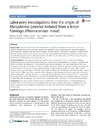Identificador persistente para citar o vincular este elemento:
https://accedacris.ulpgc.es/handle/10553/52604
| Título: | Laboratory investigations into the origin of Mycoplasma synoviae isolated from a lesser flamingo (Phoeniconaias minor) | Autores/as: | Catania, Salvatore Gobbo, Federica Ramirez, Ana S. Guadagnini, Davide Baldasso, Elisa Moronato, Maria Luisa Nicholas, Robin A. J. |
Clasificación UNESCO: | 3109 Ciencias veterinarias | Palabras clave: | Aereosacculitis Lesser flamingo Mycoplasma synoviae Phoeniconaias minor VlhA |
Fecha de publicación: | 2016 | Publicación seriada: | BMC Veterinary Research | Resumen: | Background: The role of wild birds in the transmission and spread of mycoplasmas is not clear. Up to now different Mycoplasma species have been isolated from wild birds many of which are not considered pathogens sensu stricto for domestic flocks. This report describes the first isolation of Mycoplasma synoviae in a captive lesser flamingo (Phoeniconaias minor) held in a zoo in Italy and the laboratory investigations performed to elucidate its origin. Results showed that the strain was similar to the MS-H vaccine strain using the vlhA methods although no vaccination with this product was used in the zoo. Case presentation: This paper describes investigations into a case in which 10 of 12 adult lesser flamingos (Phoeniconaias minor) died after having recently been moved from the Netherlands to a new zoo in Northern Italy. While most of the birds appeared to have died from the stress of movement and poor adaptation to their new environment, Mycoplasma synoviae, an important poultry pathogen in the layer and meat industry, was isolated for the first time from the trachea of one animal presenting catarrhal tracheitis and fibrinous airsacculitis. Genetic analysis of the conserved region of the vlhA was not able to differentiate the flamingo strain from the MS-H vaccine strain. However differences in the sequences of the obg gene of the flamingo and vaccine strain were detected. A test for temperature-sensitivity (ts) gave a ts - phenotype for the flamingo strain, in contrast to the ts + status of the MS-H strain. Based on this information and knowing that the flamingos were not vaccinated against M. synoviae, it is highly likely that the flamingo was infected with a genetically similar wild strain by contact with infected birds. Conclusions: This case provides evidence for the potential role of international trade of ornamental birds as a possible route of introduction of new mycoplasma strains between countries, and moreover highlight that vlhA gene sequencing was not sufficient to discriminate the wild strain isolated from the flamingo from the MS-H vaccine strain. | URI: | https://accedacris.ulpgc.es/handle/10553/52604 | ISSN: | 1746-6148 | DOI: | 10.1186/s12917-016-0680-1 | Fuente: | BMC Veterinary Research [ISSN 1746-6148], v. 12, article number 52 |
| Colección: | Artículos |
Citas SCOPUSTM
21
actualizado el 18-may-2025
Citas de WEB OF SCIENCETM
Citations
19
actualizado el 11-may-2025
Visitas
211
actualizado el 25-ene-2025
Descargas
200
actualizado el 25-ene-2025
Google ScholarTM
Verifica
Altmetric
Comparte
Exporta metadatos
Los elementos en ULPGC accedaCRIS están protegidos por derechos de autor con todos los derechos reservados, a menos que se indique lo contrario.
